What is Marquetry? | Wooden Crafts from the Nature of Japan
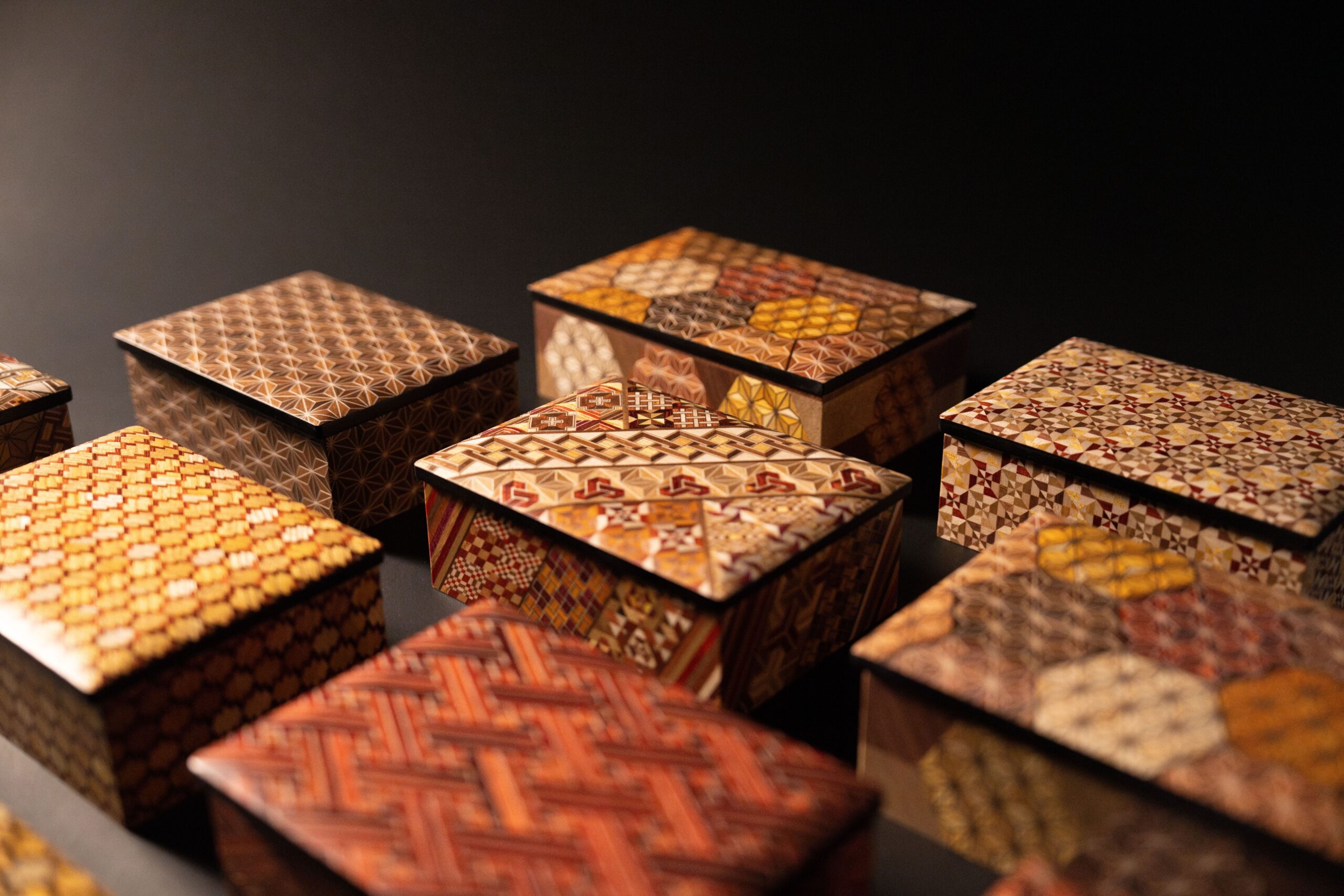
Yosegi-zaiku is a traditional Japanese woodworking technique that has been handed down mainly in the Hakone region of Kanagawa Prefecture. This technique combines different types of wood to create geometric patterns, resulting in beautiful ornaments and utilitarian objects. Its origins date back to the Edo period (1603-1867), and it makes use of the wide variety of woods nurtured in Hakone's rich natural environment.
Today, marquetry is not only a tourist souvenir, but also a craftWorldwide recognitionMarquetry is also attracting attention as a furniture and interior decoration item. Let's take a closer look at the characteristics, history, production techniques, and modern uses of marquetry.
withered
Article
Features and Attractiveness of Marquetry
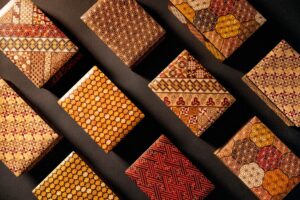
The most important feature of marquetry is,The point where the natural colors and grains of different woods are skillfully combined to create intricate geometric patternsThe technique is found in the following. In this technique, no staining or coloring is used and the focus is on bringing out the color of the wood itself. The following three characteristics are listed below.
1. the beauty of geometric patterns
Marquetry patterns are created by craftsmen who painstakingly select the wood and create them according to a calculated design. Traditional Japanese patterns such as "asanoha" and "kakureshi" are used in particular to fascinate the viewer.
2. design utilizing natural colors
Because the colors of the wood itself are utilized, the patterns have a natural and warm coloring. This gives each piece a unique finish.
3. high practicality and durability
Marquetry not only offers decorative beauty, but also functionality as a practical product, such as a tea box, drawer, or puzzle box. Carefully crafted products can be used for a long time and continue to be used with love.
The charm of marquetry lies in the beauty of the patterns created by craftsmen's handiwork and the practicality of integrating them into daily life.
History and Development

The origin of marquetry dates back to the late Edo period. Craftsmen in the Hakone-Yumoto area developed the technique to please the eyes of travelers visiting the area.
Edo to Meiji Period
During the Edo period, Hakone's rich forest resources were utilized to create marquetry using a variety of woods. Hakone's marquetry is known as "Hakone craftAlso known as "tokyo," they were popular as souvenirs for travelers passing on the Tokaido Highway.
In the Meiji period (1868-1912), Japanese traditional crafts attracted worldwide attention, and marquetry work began to be exhibited at international expositions. Due to this,Its beauty has become well-known overseas as well.In the early 1980s, the first of these products were made for export.
Modern Development
Today, marquetry has become an established local brand in Hakone. Not only traditional products, but also many new pieces incorporating modern designs are being created. In addition, efforts are being made to promote the techniques and appeal of marquetry through workshops and hands-on programs for tourists.
Production Techniques and Craftsmanship
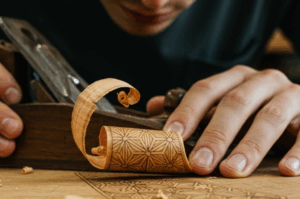
Calculation and meticulous handwork are essential to the production of marquetry. The process includes the following techniques
1. wood selection and processing
The appropriate material for the pattern is selected, taking into account the color and hardness of the different woods. The wood is cut into small pieces and beveled or grooved as needed.
2. combination of patterns
The selected pieces of wood are combined and glued together to form a single board. At this point, work is carefully carried out to ensure that the patterns match precisely.
3. processing to thin plate
The glued patterned board is further processed into a thin sheet. This sheet is then applied to the surface of the marquetry product.
4. finishing
After the surface is polished and smoothed, it is finished with varnish or wax. This finish gives the marquetry a unique and beautiful luster.
Muku" and "Zuku" marquetry techniques
Marquetry is a traditional Japanese craft that combines colorful natural woods to create geometric patterns. The terms "muku" and "zuku" are used in this technique, which indicate the method of production and the way the materials are finished.
Muku (solid wood): Utilizing the wood itself
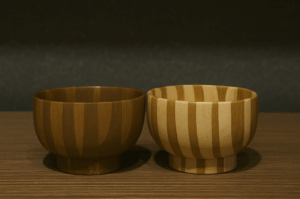
<Product example: sake cup
Muku" refers to a technique in which natural wood is carved directly into shape. In yosegi-zaiku, the wood is assembled into a single block, and the shape of the product is carved directly from that block. This method brings out the texture and massiveness of the wood as it is, and provides an excellent finish in terms of durability.
Zuku (paste): thinly sliced and pasted together
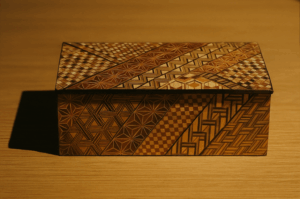
<Product example: accessory case
Zuku" is a technique of thinly slicing a marquetry pattern and pasting it onto the surface of a product. The patterned portion is thinly sliced from a block of wood, and the slices are pasted onto the surface of a box or tray to finish the product. This method highlights the beauty of the pattern while keeping the product lightweight.
Choice of technique and characteristics of the work
The muku technique is suitable for pieces that emphasize the texture and massiveness of wood, and is used for items that require durability. The zuku technique, on the other hand, is suitable for pieces where the beauty of the pattern is emphasized while the product is lightweight. Each technique has its own unique charm, and they are used differently depending on the purpose and design of the work.
Because zuku uses luxurious wood and requires advanced techniques and labor to carve it, material loss and processing costs inevitably increase. As a result, zuku products tend to be more expensive than muku products, but they are finished with a greater sense of weight and presence.
Hakone Yosegi Product Introduction
1. secret box
Himitsu-bako (secret box) is a representative product of Hakone marquetry, a trick box that can only be opened by sliding it in a certain way.
- how it is used: In the Edo period, travelers used it to hide their valuables. Nowadays, they are popular as interior decorations and gifts to be enjoyed like puzzles.
3. accessory box or tray
Small accessory cases for storing jewelry and keys, and trays for drinks and snacks are also made from marquetry.
- how it is usedIt is: a practical product that can be used conveniently in daily life, but also excels as a decorative item.
4. cell phone case or business card case
Contemporary marquetry products include phone cases and business card holders.
- how it is usedIt is popular as an item that allows people to enjoy traditional techniques in their daily lives.
Echizen-Yosegi

In our store, along with Hakone marquetry, a traditional handicraft, we offer a wide range of traditional marquetry products, such as "Hakone Marquetry", which was born in Echizen City, Fukui Prefecture.Echizen yosegi - tataWe also deal in the works of "tata". tata" is a company that creates items to enrich people's lives by utilizing scrap wood produced by carpenters during house construction and using the technique of yosegi (marquetry).
Echizen Yosegi is characterized by its use of the natural color and grain of the wood to create unique patterns. In particular, Echizen Yosegi creates unique patterns by combining long, thin pieces of scrap wood and cutting them out like Kintaro candy, resulting in a unique design with the same pattern on the front and back sides of the piece.
The "tata" works are,Each piece is handcrafted by artisans and can be made to order.The following is a list of the most common problems with theWe can consult with you on the size and design according to your requests for "something like this" in your daily life.
The Echizen marquetry of "tata" is a one-of-a-kind work of art that brings out the natural texture of the wood, and is loved by many as an item that adds warmth and color to everyday life.
At the end.
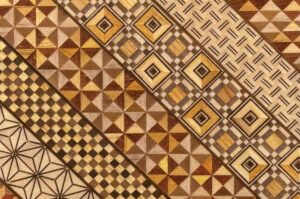
Marquetry is a traditional craft that combines the beauty of wood created by Japanese nature with the skills of craftsmen who make the most of it. Its patterns are imbued with the Japanese sense of beauty and respect for nature. Today, while preserving traditional values, new designs and techniques are being introduced to further evolve the craft.
We invite you to experience firsthand the fascination of marquetry by touching one of our marquetry pieces. Each product is a one-of-a-kind work of art created by the hands of artisans.

